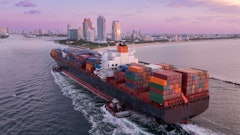
Container stack collapses; vessel instability; injury to dock and vessel workers; damage to cargo, ships and port machinery; insurance claims; and significant environmental impact—incidents such as these are intensifying the urgency for an accurate container weight. With more megaships on the horizon, the scale of a potential event is looming even larger. And in today’s modern, multimodal container ports, there’s also the ripple effect on rail and truck industries as cargo is transferred to its final or intermediate destination.
With approximately 10 percent of ocean cargo citing an inaccurate weight, according to Loadstar, it is an industrywide problem—so much so that the International Maritime Organization (IMO) implemented an amendment to existing Safety of Life at Sea (SOLAS) legislation that requires containers and their contents to be weighed before loading.
The regulation went into effect July 1, 2016, when loading a packed container was prohibited in many locations if the operator and marine terminal did not have a verified container weight or verified gross mass (VGM) on file. On May 23, however, the IMO issued memorandum MSC.1/Circ.1548 stating that countries take a “practical and pragmatic approach” to enforcing the requirement for three months after July 1, 2016. What exactly does this mean for the global export industry?
Importance of July 1 and October 1 Dates
The enforcement regulation is still in the hands of individual nations. Despite the call from the IMO for flexibility, many carriers and countries keep saying there will be no exceptions, even if the publication of the legislation takes place after July 1. October 1 is noted as the closure date on any flexibility that may be allowed. At that time, it can be interpreted that full enforcement will begin as specified in the original regulation. It is also important to note that if a country did not publish national legislation on the subject, the SOLAS amendment is still in force.
VERMAS Is the Preferred Way of Communicating Container Weight
The regulation stipulates that shippers, as noted on the master bill of lading, are responsible for providing a VGM to carriers. To communicate VGM information, an electronic data interchange (EDI) message was developed called the verified gross mass message (VERMAS). Designed to contain all of the required information, including optional fields, it is the preferred way of communication for many carriers, freight forwarders, ports and shippers. This methodology minimizes the impact to the existing communication of shipping instructions and other messages, and expedites the shipping instruction deadline to meet the new VGM closing of the carrier.
Compliance Is a Significant Change for Ocean Trade
Although obtaining a verified weight may sound simple in theory, a number of complex factors, scenarios, parties and practical considerations are actually at play. From the calibration of weighing equipment to how cargo should be weighed, when weighing should occur in the supply chain and even how to account for simple variances in humidity, complying with the mandate is not easy. Additionally, while shippers need to use the correct tare weight of the container, not all containers have the same weight. In theory, the weight stated on the door of the container should be used. Some carriers may provide information tables for their own containers, but there is no single database of all tare weights.
Technology Can Help Centralize Information Management and Communication
The new requirement is also about moving data, as well as maintaining and improving ocean safety. As an alternative to manual submission of a VGM certificate (with no fixed layout), many shippers and intermediaries are evaluating technology solutions that can help transmit required data in the right format at the right time. In addition, data transmission times may vary between ports, carriers, shippers and the vessel, as well as messaging protocols. Data that exists in current enterprise resource planning (ERP) and other systems may also need to be reviewed for accuracy. Technology can help organizations move into compliance by simplifying these complexities, and centralizing processes for VGM, shipping instructions, bookings and more, and offering a complete book-to-bill workflow.
Nations Are Pursuing Readiness at Same Level of Urgency
The amendment is applicable to all 171 IMO member countries, which includes nearly all countries with ports. Most nations are reacting to the update with the same level of urgency as before the memo, although translation of the regulation remains an ongoing issue. In addition, differences in certification of equipment and methods, and differences in tolerances created some confusion in the industry. For instance, some countries noted an acceptable margin of error of up to 5 percent, while others have a zero-tolerance policy. The World Shipping Organization will continue to track the progress of each nation as country-specific differences are refined.
For more information on the SOLAS VGM requirement, please visit Descartes’ Resource Center and e-book, and here for an overview of country-specific information on VGM.















![Pros To Know 2026 [color]](https://img.sdcexec.com/mindful/acbm/workspaces/default/uploads/2025/08/prostoknow-2026-color.mduFvhpgMk.png?ar=16%3A9&auto=format%2Ccompress&bg=fff&fill-color=fff&fit=fill&h=135&q=70&w=240)

